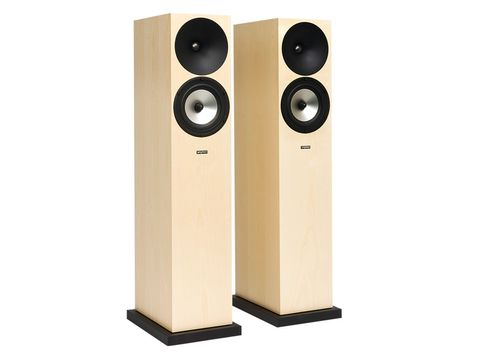TechRadar Verdict
A bit pricey, perhaps, but the very solid build ensures an impressively clean sound with loads of bass and fine neutrality. Waveguide-loaded tweeter delivers superior coherence and imaging.
Pros
- +
Nice Scandinavian design
- +
Brilliant enclosure design
- +
Clean and neutral sound
Cons
- -
Bit pricey
Why you can trust TechRadar
A relatively new brand on the scene, Amphion operates out of the heart of Finland and has recently brought the Argon 3L, their new Floorstander to our attention. Its particular USP is the use of waveguides to load its tweeters, for a number of very good reasons.
A waveguide is a species of horn with a truncated throat and a very wide flare. First, Amphion claims that it increases the efficiency at the bottom end of the tweeter pass-band and, therefore, allows the crossover point to be lowered, to around 1.2kHz.
Secondly, it helps match up the acoustic sizes of the bass/mid and treble drivers. Thirdly, by recessing the tweeter proper with respect to the front panel, its voice-coil-to-listener distance becomes similar to that of the cone driver, improving the time-alignment and simplifying the crossover transition.
Although details of the brand new Argon 3L are still sparse, it appears to have a great deal in common with the Argon 2 Anniversary. Both appear to share the same drive units and crossover network, but the key difference is that the 3L is a very substantial floorstander, whereas the 2 is a much smaller standmount.
While there's no question you get a much larger, very handsome and exceptionally solid enclosure here – and consequently superior bass performance – the extra cost is considerable. Whereas the Argon 2 price was £1,200-£1,400, this Argon 3L costs nearly twice that at £2,300-£2,600.
The justification is that enclosures are the most expensive part of a speaker and floorstanding enclosures need much more substantial engineering to match the performance of a standmount enclosure. It is, therefore, very significant that the Argon 3L weighs nearly 50 per cent more than a lot of other floorstanders.
Like all Amphions it has super-clean, sharp edged Scandinavian lines, very much in the Art Deco tradition. No overall grille was supplied, but the tweeter is well protected by its own grille and position: deep down the black-coloured waveguide.
The speaker comes complete with a proper plinth that improves the overall stability, enhances the appearance, and securely locates the spikes. The SEAS-sourced tweeter has a 25mm titanium-dome diaphragm, while the 165mm bass/mid driver has a 115mm metal cone surrounding a fixed 'bullet' pole extension.

BACK PANEL: Use the supplied foam bungs if you need to keep this speaker close to a wall
A single pair of high-quality WBT terminals is fitted, below a large diameter rear port and foam bungs are supplied to block the ports if preferred.
How do they sound?
Although it's clearly best to keep these speakers well clear of walls, if the bungs are used, some close-to-wall proximity will probably be acceptable. Interestingly, even though there is some bass excess, because it remains clean with no apparent overhang it doesn't seem to pose any sort of problem subjectively.
If anything, it is something of a bonus adding weight and scale rather than unwanted thickening or thump. That heftily engineered and notably quiet enclosure is one of this design's hallmarks, as are the essentially pistonic metal diaphragms.
Together these give the Argon 3L a distinctive character – smooth, clean, neutral and very well controlled, with a wide dynamic range as a consequence of the low enclosure noise floor. As a result, it sounds a little less 'busy' than some of the alternatives and a little less dynamically demonstrative, too, but the fine accuracy and coherence are their own reward.
Coloration is low, especially through the bass region, though voices do have a hint of nasality. Focus is very good, so images have a welcome solidity and good perspectives.
Follow TechRadar reviews on Twitter: http://twitter.com/techradarreview

This has to be the most absurd portable power station ever launched — Asus's Mjolnir throws the hammer at rivals with innovative design that's likely to divide opinions

Pixel's new satellite feature could show people where you are on Google Maps

I really hope Google doesn't promise 7 years of Android for the Pixel 8a
